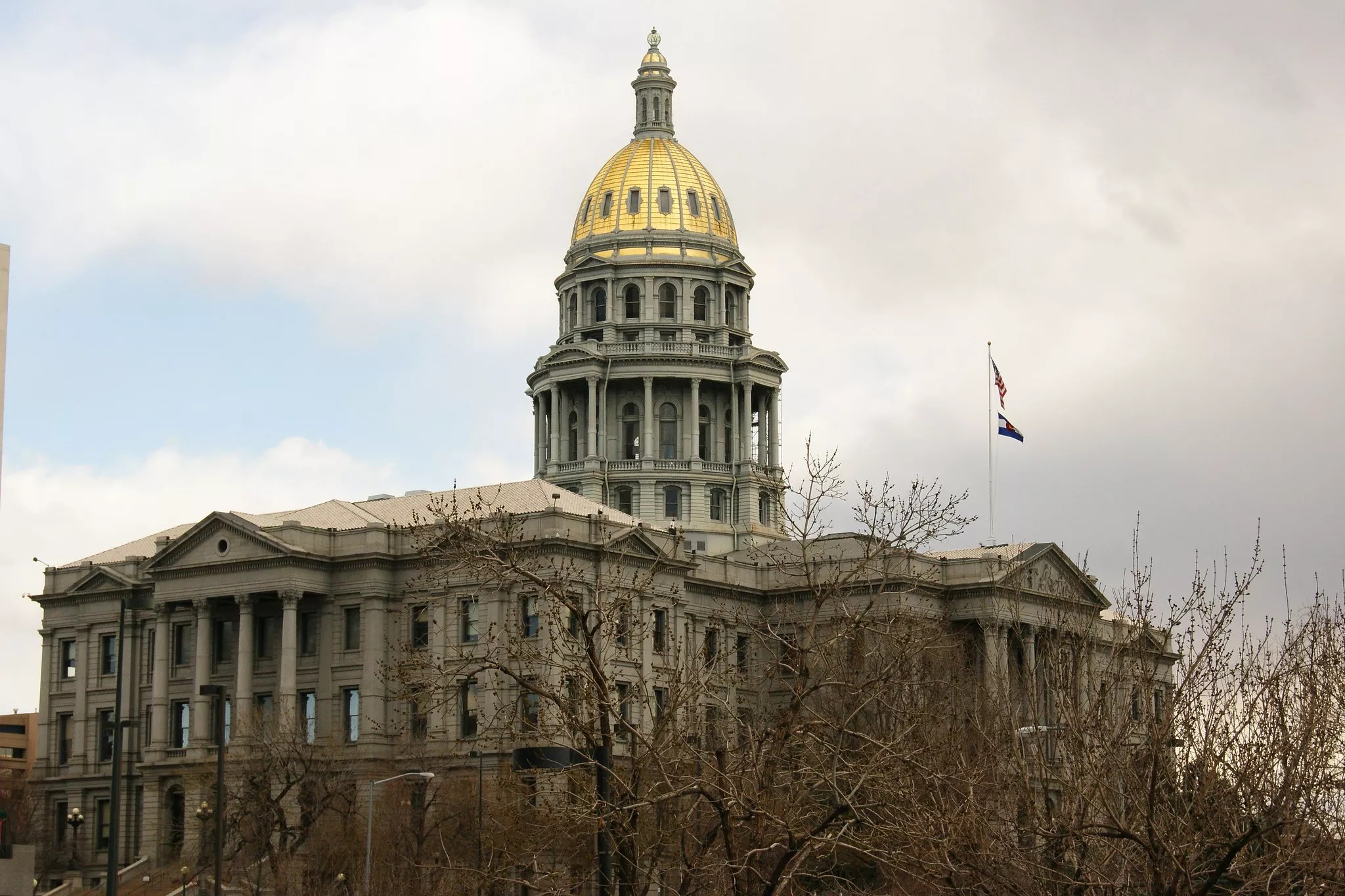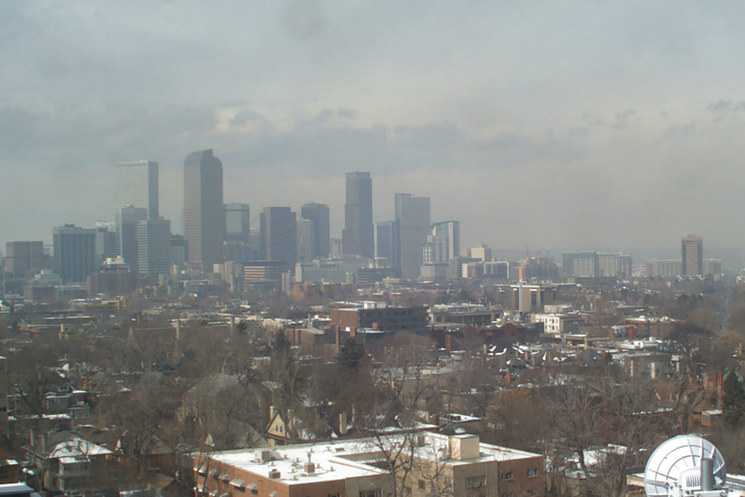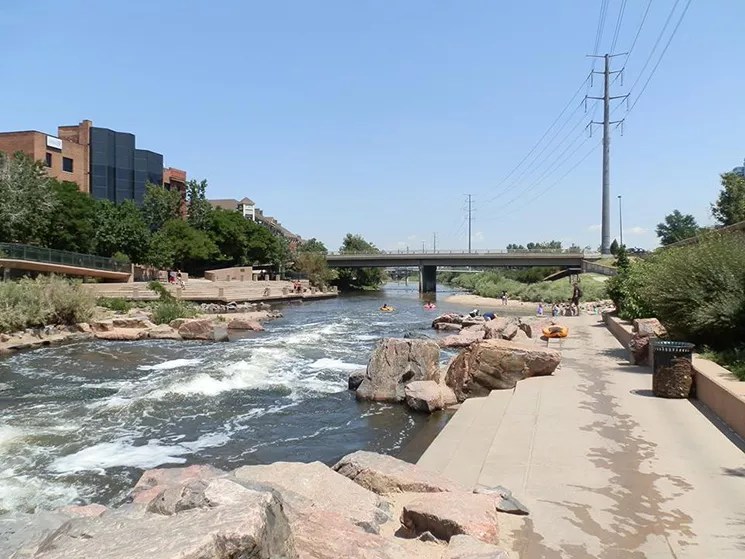

Audio By Carbonatix
Despite a last-second crunch that killed one bill, many of the state’s environmental advocacy groups say they’re pleased with the final results of the Colorado legislative session, after key measures involving air toxics, water, chemical regulation, building construction and transportation made it through.
Ean Tafoya, state director of GreenLatinos and a Denver mayoral candidate, had been working on the Public Protections From Toxic Air Contaminants bill for five years. “I cried, actually, when it passed. I was just so excited,” he says. “It’s a transformational step. The people who were advocating for the Clean Air Act in the first place were advocating for these issues, so it felt like a generational win.”
The national Clean Air Act, which was approved in 1970, had promised that health-based standards for air toxics would eventually be adopted across the country. So far, though, the feds have only issued National Ambient Air Quality Standards for six; this bill allows Colorado to kick-start the process of issuing ambient air-quality standards for more.
According to Becca Curry, Colorado policy counsel for EarthJustice, an environmental organization that supported the bill, while changes were made to the regulatory aspects of the proposal, the informational aspects remained the same. The state will now be charged with identifying adverse health impacts from air pollutants; it will also increase its air toxics monitors from one monitoring about twenty toxics to six monitoring 62 toxics.
Will you step up to support Westword this year?
At Westword, we’re small and scrappy — and we make the most of every dollar from our supporters. Right now, we’re $20,000 away from reaching our December 31 goal of $50,000. If you’ve ever learned something new, stayed informed, or felt more connected because of Westword, now’s the time to give back.
Under this bill, the state will eventually end up with an air toxics inventory similar to the national Toxics Release Inventory. Activists have long pushed for a faster turnaround on air toxics numbers – the most current data dates to 2020 – so the state inventory will have a faster timeline, include more local polluters and expand to a broader range of toxics. Initially, the bill had called for including the newly identified health-based standards in the permitting process conducted by the Air Pollution Control Division; as passed, it calls for the state to commission a study by 2025 identifying what an expanded air toxics permitting program could look like. And by 2026, the Air Quality Control Commission will identify five priority air toxics that will be subject to emissions control regulations from that point on. The commission will revisit the process every five years.
“We’re talking about things like retrofits to equipment, or it could be more frequent leak detection schedules, or it could be an emission limit,” Curry says. “There’s a whole sort of suite of what emissions control regulations could mean.” Another amendment required that the legislature give final approval to any health-based standard before it’s implemented.
As approved, the bill makes it clear that the state is empowered to go beyond what the EPA regulates in terms of air toxics, removing a historic barrier to air-quality regulation in Colorado. “It’s not a perfect bill, but it’s a significant step for our state,” Curry says.
The state took other steps toward improving air quality with several transportation-related bills. Programs to Reduce Ozone Through Increased Transit calls for offering free public transit for at least thirty days during ozone season; for RTD, those days will likely be the month of August.
The proposal also adds more money for the Colorado Department of Transportation’s Bustang routes along the Front Range, notes Travis Madsen, transportation program director for the Southwest Energy Efficiency Project. “I have to go to Fort Collins for a business trip next month,” Madsen says. “[Bustang] doesn’t really work for a one-day run-there-and-run-back kind of thing. I think adding more buses going more often will really increase the usefulness of that service.”

Advocates pushed for clean air.
CDPHE
Another bill that will help air quality through transit is State Grants Investments Local Affordable Housing, says Madsen. One provision of that legislation is the strong communities grant program, which makes $40 million available to local governments that do planning projects that increase the supply of affordable housing in places where people will have access to transportation options other than driving, including biking, walking or riding the bus. “Forty million dollars is not enough money, but it’s a good start,” he notes. “I think we’ll be seeing a lot more policies along these lines in future years in Colorado, so this is a solid, solid start.”
Another bill, Air Quality Improvement Investments, allocates $100 million in funding for a variety of transportation projects designed to improve air quality in the state, including $12 million allotted for electric bikes, $65 million for electric school buses and $25 million for energy efficiency in the transportation industry. The new state funding, along with money that came through Congress late last year, should be enough money for Colorado school districts to replace most diesel buses with electric buses within the decade, Madsen says.
Water was also a focus of environmental advocates, who pushed Water Quality Regulation, a bill inspired by the Water Quality Control Commission‘s refusal to upgrade protections to the South Platte River; upgraded protections would require stricter permitting on entities that discharge pollutants into the river. “This was a pretty big decision related to the South Platte, and it wasn’t publicized,” Curry says. “It was just buried in this packet of rulemaking materials that was like 200 pages long, and so there was no specific outreach to communities.”
The WQCC will revisit that decision in the fall; this bill outlines required outreach and engagement procedures, including holding meetings and using multiple means to contact the community, as implemented by the AQCC after last year’s landmark environmental justice bill, Environmental Justice Disproportionate Impacted Community.
Water Quality Regulation also extends the statute of limitations for water-quality violations from one year to five, giving advocates more time to oppose bad decisions and practices; according to Tafoya, this will provide more tools to fight for the protection of the South Platte River.
Green building codes also came up during the legislative session, especially in connection with reconstruction after the Marshall fire. With Building Greenhouse Gas Emissions, lawmakers aimed to help local governments transition to greener energy codes.
According to Christine Brinker, senior buildings policy manager for SWEEP, the bill updates the minimum requirements for new construction. “Previously, local governments could choose between one of the three most recent versions of the energy code – the International Energy Conservation Code – and this moves up that minimum to the latest energy code, which is the 2021 International Energy Conservation Code,” Brinker explains.
The bill also requires that new buildings have the wiring necessary for electric vehicles and zero-emission heating and cooling. The updates are projected to save each new house 9 percent on its energy bill.
“I can’t even count how many amendments [the bill] had, but those were a result of so many stakeholder groups. It ended up being a lot more collaborative of a process, and thus will get a much better result,” Brinker says. One of the big changes designed to help local governments: Rather than imposing a date by which the new codes must be adopted, upgrades will be added on the government’s standard timetables. The bill also established an energy code board – made up of stakeholders including cities, rural areas, building owners and builders – that will determine the exact language for what local governments are required to implement.

The South Platte River could get cleaner
Walk Ride Colorado Facebook page
Another building bill, Policies to Reduce Emissions From Built Environment, provides a 10 percent tax credit for heat pumps, a method of temperature regulation in homes that doesn’t use natural gas. The credit, which will be available in 2023 and 2024, also applies to other equipment necessary to support a heat pump, but not the labor required to install it. “The idea is to really give the market a boost,” Brinker says. “We know that the technology is there. It works really well in our climate. The market is still trying to catch up.”
A second part of that bill allows the state to give sales tax credit for building materials with low global-warming potential; those could include recycled materials, low-carbon concrete, low-carbon steel and certain kinds of timber wood. Another approved proposal allots additional money specifically for ground-source heat pumps that typically cost more.
The state dedicated several bills to further regulating substances that could harm people or the environment. Among them was the PFAS bill, which prohibits the sale or distribution of carpets or rugs, cookware, cosmetics, fabric treatments, food packaging, juvenile products, oil and gas products, textile furnishings or upholstered furniture that contain intentionally added PFAS chemicals, starting in January 2024. PFAS are forever chemicals that some studies have found to cause adverse health effects in humans.
“We didn’t ultimately end up banning all PFAS, so I think we’re going to have to go back to do more work on that,” Tafoya says, adding that he still considers the bill a good first step.
Another step toward chemical transparency was Oversight of Chemicals Used In Oil & Gas, which requires oil and gas operators to disclose what chemicals they use in fracking fluid. Curry compares it to an ingredients list on food or drinks, informing people what’s going into their bodies. With this, people will now know what is going into the earth.
Advocates were disappointed by some losses, particularly the death of Reduce Greenhouse Gas Emissions in Colorado, a bill that included provisions to electrify small engines such as lawnmowers, incentivize growing crops alongside solar farms, and generally reduce greenhouse gas emissions. It was sacrificed on the second-to-last day of the session.
“It was the sort of prime target of the Republicans,” Curry says. “In a deal that was made at like 4:30 a.m….there was an agreement made to kill that bill in order to end the filibuster that was putting many bills at risk.”
Madsen says he was sorry to see that bill killed, because devices that use those engines contribute to ground-level ozone pollution.
Advocates agree that this session cleared the air about several of this state’s big environmental issues, and will help prevent future problems.
“In some cases, the benefits are hidden,” Brinker says. “Sometimes we don’t notice these benefits until they’re gone. Like the benefit of clean air. We really noticed how great that is when we had those fires and had such bad air quality. Similarly, we don’t really notice the quality of construction of our houses until there’s a problem with it.”
But legislators took real steps toward improvements this session, she adds: “It seemed like, at the very beginning, the legislation was a lot more limited because of fiscal concerns as well as it being an election year. Then, toward the middle of the session, it expanded when legislators grew in their conviction that we need to take action on these things. In the last days of the session, of course, it always narrows down with negotiations and, just frankly, time.”
For environmental groups, the work continues. With time, Tafoya hopes language considerations will become ingrained in environmental justice bills. “What our community told us…through the pandemic was that the government was not prepared to communicate public health information and emergency information in a meaningful way,” he notes.
The state is still seeing the impact from some 2021 bills, including the Environmental Justice Action Task Force that Tafoya co-chairs. That task force will submit recommendations for environmental-justice policies in November; in the meantime, it will continue to meet with the public to develop those recommendations.
“The environmental-justice coalition in the state of Colorado continues to grow,” Tafoya concludes. “The concern about our issues continues to grow. We’re a bigger and more bold environmental-justice coalition, and we’re getting wins for the health of people and for the future.”